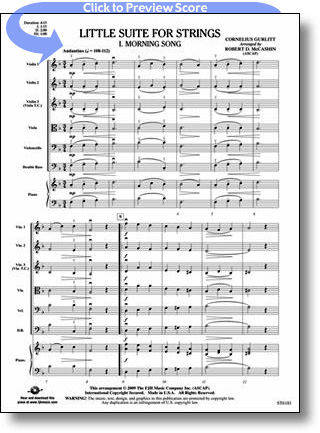Little Suite for Strings
Product ID: FJ2 DS ST6181
By Cornelius Gurlitt
Publisher:
FJH music
Arranger:
McCashin
Series:
FJH Developing Strings
Line Up:
String Orchestra
Duration:
4:15
Level: 2.5
Set & Score
This item is in stock
About this item
This short three-movement work is the perfect choice to introduce your students to a multi-movement suite at the developing strings level. Drawn from two of Cornelius Gurlitt’s well-known piano works, the movements include Morning Song, Song in Twilight, and March. Extremely well arranged, and a wonderful new gem to use for the classical portion of your program.
Songlist (3)
- Morning Song
- Song in Twilight
- March.
Instrumentation
Strings
Piano
Reviews and rating
No review available, be the first to write one!

Composer
Cornelius Gurlitt (1820-1901)

Cornelius Gurlitt (February 10, 1820 – June 17, 1901) was a composer born in Altona, Schleswig-Holstein. He was a classmate of Carl Reinecke, whose father was head of the famous Leipzig Conservatory. Gurlitt studied with Reinecke's father for six years. His first public appearance at the age of seventeen was well received, and he decided to go to Copenhagen to continue his studies. There he studied organ, piano, and composition under Curlander and Weyse. While in Copenhagen he became acquainted with the Danish composer Niels Gade, and they remained friends until the latter's death.
In 1842, Gurlitt moved to Hørsholm, where he resided as organist and music teacher for four years. He then moved to Leipzig, Germany, where Gade was musical director for the Gewandhaus concerts. Gurlitt next travelled to Rome, where his brother, Louis Gurlitt, a well-known painter, was studying. Cornelius Gurlitt's abilities as a musician were quickly recognized in Rome, and the papal Accademia di Santa Cecilia nominated him an honorary member, graduating as a Professor of Music in 1855. While in Rome he also studied painting with excellent results. On his return to Altona, the Duke of Augustenburg engaged him as teacher for three of his daughters. When the Schleswig-Holstein war broke out in 1849, Gurlitt became a military band master. His output was prodigious in quantity and breadth, ranging from songs and teaching pieces to operas, cantatas, and symphonies. He died in Altona. He very much loved music but wanted music to educate people, not to entertain people. Therefore he wrote many pieces like 'Vivace' and 'Waltz'.
More info about the composer...



 Click above to view samples
Click above to view samples
